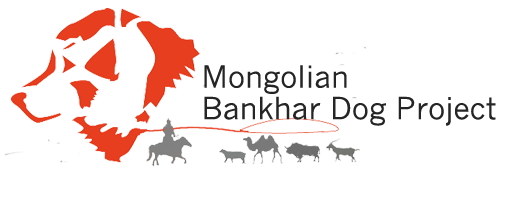As many of you may have heard, MBDP recently brought a young male Bankhar to the U.S. His name is Baavgai (‘Bear’ in Mongolian), named after his father. We were pleased to receive so many questions and lots of interest from our followers, so this blog post is to summarize why we’ve brought a Bankhar to the U.S. and what we hope to learn from him.
The goal is to test the innate livestock protection ability of the Bankhar. This is difficult to assess in the field in Mongolia where we only get to see our dogs periodically after they get placed with their herder, compounded by the many variables in raising and training the individual dogs. While we are happy with the training protocol we are implementing, we also wanted to place pups with experts in raising livestock guardian dogs of different breeds.
The select few Bankhar that we bring to the U.S. or breed here will be placed in high predator pressure areas (i.e. Yellowstone area) so we can see how well they work in that environment, trained by experienced livestock guardian dog practitioners. While this will amount to a small data set it, collecting this type of information is critical to helping us refine our protocol and ensure that we are on the right track with how we are advising our participating herders in Mongolia.
- Normal face…
- Just like in Mongolia, Baavgai is learning to live among a flock of sheep.
An important note: We will not be breeding dogs outside Mongolia for any other reason besides these assessments.All the dogs we place outside of Mongolia will be altered. We feel strongly that this could to lead to genetic bottlenecks and loss of control of the genetic line (increased inbreeding, etc). Additionally, we respect the cultural significance of the Bankhar to Mongolia. These dogs are a part of that country’s heritage and Bankhar are rare enough for herders already. This is a Mongolian landrace best left to breed in it’s region of origin.
Some of you have inquired about other Bankhar in the U.S. While there have likely been other individual dogs brought over by others, we have only brought over one other Bankhar to the U.S. Three years ago we brought a red-yellow male because he was a color herders in Mongolia did not seem to want at the time. He is neutered and working in extreme northern USA. He is with two other livestock guardian dog breeds and is, according to the farmers, “their best dog.”
- Baavgai weather a Connecticut snow storm with his flock.
- One of our dogs, Sharaa; an example of the red/yellow coat color.
- Blimpie here has a more typical black and brown/redish coat.
This issue with color is sometimes important to herders as they feel any dog other than the black, or black and with brown markings, will scare the livestock since the livestock will think they are wolves (because of somewhat similar colors). However, now that we have gained credibility to provide very healthy and effective working dogs, we are able to get more herders on board with the wider varieties in which Bankhar once regularly occurred. This is a major plus as it allows us to keep the genetic diversity high since we do not have to breed based on color and lose those or other associated genes that might be inherited with a particular color.
We welcome any and all comments and questions about all aspects of the project. Keep them coming and please check back in for more updates about this new stage of our program!
-Zoë & Bruce














Comments(2)-

-

Tsetsen says
January 5, 2018 at 9:37 pmit would be very interesting to read further updates on this project. Obviously, it is a great job. I am sure Baavgai will justify all your efforts. I wish you lot of success.
Zoe Lieb says
January 6, 2018 at 4:19 amThank you! We appreciate you reading and following along on this part of our progress.